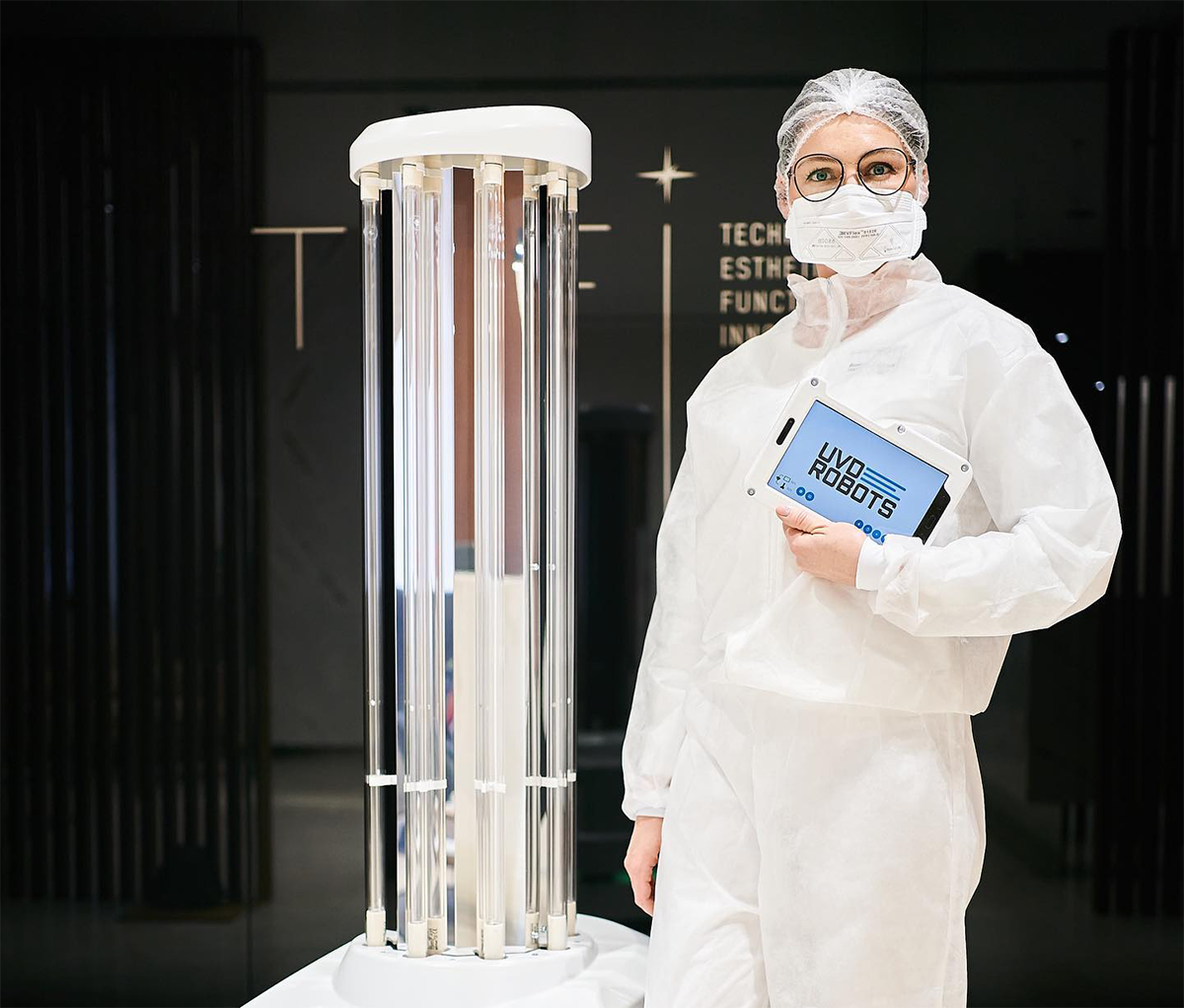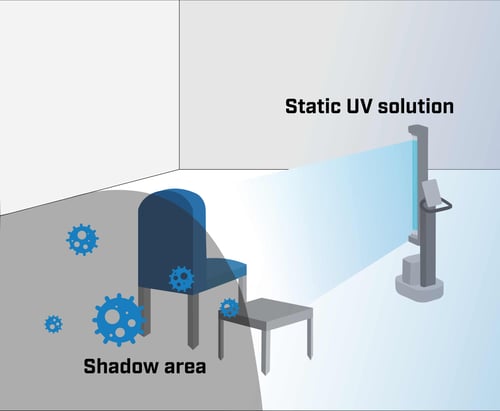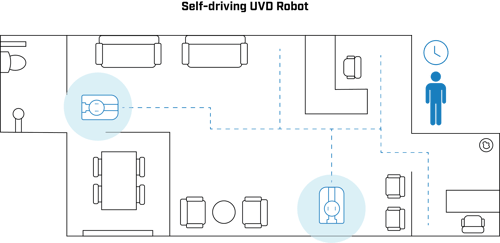Title
Content
Title
Content

Ultraviolet germicidal irradiation, or UVGI, can be used to disinfect areas with UV light within indoor environments. Objects can obstruct UVGI, however, and result in a process called shadowing. Here is a breakdown of how it happens – and how shadowing can be avoided.
Indoor areas are subject to the presence of environmental microorganisms. This has been recognized as particularly pronounced on inanimate surfaces such as door knobs, counters, desks, floors, and walls.1
To remedy this, different forms of disinfection methods have been implemented, such as disinfection with chemicals, and the implementation of copper-based materials.2 These methods have varied in their efficacy, as well as their safety in laboratory conditions.3 4
Since this has been the case, there has been an increasing interest in other disinfection methods, such as Ultraviolet germicidal irradiation, or UVGI.5 UVGI typically refers to using Ultraviolet (UV) light to disinfect surface or air spaces of different microorganisms, including:
The UV light used in UVGI disinfection methods typically falls within a certain wavelength range. A known disinfecting wavelength range is that of 200 to 280 nanometers (nm), also known as UV-C light.7
UV-C light at 254 nm has been developed for specific use in UVGI practices.8 Often emitted from low-pressure lamps, this particular wavelength has been associated with microorganism reduction in several laboratory studies, often to a high degree of efficacy.9 10 11
Though UV-C light in general has the ability to disinfect surfaces,12 its capabilities, depending on the means of its application, may have some limitations. These limitations include those of:
When it comes to disinfection purposes, UV-C light can be hindered by objects that obscure target areas.15 This is determined by a measurable reduction in UV dose, or the amount of radiation of UV light in a given area, expressed in millijoules per square centimeter(or mJ/cm2).16
UV-C light has been known to have a limited disinfection effect in areas of shadow.17 18 For example, one laboratory study associated a decreased reduction of microorganisms with shadows created from irregular surface conditions,19 while another study associated the obscuring composition of individual objects with limited UV-C decontamination effects.20
 Shadowing is a common issue with static or manual UV-C disinfection systems.
Shadowing is a common issue with static or manual UV-C disinfection systems.
With static or manual UV systems users often experience an issue with having to physically move the robot
- risking area contamination and increasing labor time.
UVD Robots (UVD standing for Ultraviolet Disinfection) are self-driving UVGI disinfection robots developed by the Danish company Blue Ocean Robotics, which specializes in developing mobile robots for the service industry.21
Mobile and capable of self-navigation, UVD Robots use 254 nm UV-C light for environmental disinfection. With mobility, they are capable of reaching shadowed areas of rooms, reaching areas that would otherwise be obscured.22
With the ability to bypass shadows by circling around objects, and emit UV light in previously obscured areas, UVD Robots are within the capability of reaching over 3-log reductions (or an efficacy rate of over 99.9%) in Staphylococcus aureus and Clostridioides difficile, two microorganisms commonly found in indoor environments.23
Shadowing is an environmental factor that has been associated with greatly reduced doses of UV light. Areas obscured by shadows have, in turn, been associated with reduced decontamination efficacies.24

UVD Robots is a self-navigating UV-C disinfection robot that overcomes the problems of shadowing through mobile operation. With the ability to operate freely either autonomously or through remote control, UVD Robots can reach 4-log, or 99.99% efficacy in reducing selected microorganisms in indoor environments.
Lorem ipsum dolor sit amet, consectetur adipiscing elit, sed do eiusmod tempor incididunt ut labore et dolore magna aliqua.
1. Arenas-Vivo, Ana, et al. "An Ag-loaded photoactive nano-metal organic framework as a promising biofilm treatment." Acta Biomaterialia 97 (2019): 490-500.2
2. Champagne, Victor K., and Dennis J. Helfritch. "A demonstration of the antimicrobial effectiveness of various copper surfaces." Journal of biological engineering 7.1 (2013): 1-7.
3. Jeffrey, D. J. "Chemicals used as disinfectants: active ingredients and enhancing additives." Revue Scientifique et Technique-Office International des Epizooties 14 (1995): 57-57.
4. Hrubec, Terry C., et al. "Ambient and dosed exposure to quaternary ammonium disinfectants causes neural tube defects in rodents." Birth defects research 109.14 (2017): 1166-1178.
5. Kowalski, Wladyslaw. Ultraviolet germicidal irradiation handbook: UVGI for air and surface disinfection. Springer science & business media, 2010.
6. Kowalski, Wladyslaw. Ultraviolet germicidal irradiation handbook: UVGI for air and surface disinfection. Springer science & business media, 2010.
7. Illuminating Engineering Society. “IES Committee Report CR-2-20 FAQs.” Illuminating Engineering Society, 7 Mar. 2022, www.ies.org/standards/committee-reports/ies-committee-report-cr-2-20-faqs.
8. Kowalski, Wladyslaw. Ultraviolet germicidal irradiation handbook: UVGI for air and surface disinfection. Springer science & business media, 2010.
9. Andersen, Helle Stendahl. Analysis Report: Test of UV Disinfection Robot acc. NF T72-281. Report Number 754372_Rev. 2. Danish Technological Institute, 2020.
10. Edwards-Jones, Val. "Assessment of UVD Robot Against Reduction of MultiDrug Resistant Klebsiella pneumoniae, Acinetobacter baumannii and Clostridium difficile on Surfaces." Essential Microbiology Ltd. and Melbec Microbiology Ltd., Apr. 2019, www.melbecmicrobiology.co.uk, www.essentialmicrobiology.com.
11. Kowalski, Wladyslaw. Ultraviolet germicidal irradiation handbook: UVGI for air and surface disinfection. Springer science & business media, 2010.
12. Golange, Akshay, et al. "Ultraviolet disinfection robot." Int. Res. J. Mod. Eng. Technol. Sci. 4 (2022): 2582-5208.
13. Champagne, Victor K., and Dennis J. Helfritch. "A demonstration of the antimicrobial effectiveness of various copper surfaces." Journal of biological engineering 7.1 (2013): 1-7.
14. Golange, Akshay, et al. "Ultraviolet disinfection robot." Int. Res. J. Mod. Eng. Technol. Sci. 4 (2022): 2582-5208.
15. Golange, Akshay, et al. "Ultraviolet disinfection robot." Int. Res. J. Mod. Eng. Technol. Sci. 4 (2022): 2582-5208.
16. Bolton, James R., Ian Mayor‐Smith, and Karl G. Linden. "Rethinking the concepts of fluence (UV dose) and fluence rate: the importance of photon‐based units–a systemic review." Photochemistry and Photobiology 91.6 (2015): 1252-1262.
17. Liu, Chuhan, Yaoxin Huang, and Haiqiang Chen. "Inactivation of Escherichia coli O157: H7 and Salmonella enterica on blueberries in water using ultraviolet light." Journal of food science 80.7 (2015): M1532-M1537.
18. Edwards-Jones, Val. "Assessment of UVD Robot Against Reduction of MultiDrug Resistant Klebsiella pneumoniae, Acinetobacter baumannii and Clostridium difficile on Surfaces." Essential Microbiology Ltd. and Melbec Microbiology Ltd., Apr. 2019, www.melbecmicrobiology.co.uk, www.essentialmicrobiology.com.
19. Lagunas-Solar, Manuel C., et al. "Development of pulsed UV light processes for surface fungal disinfection of fresh fruits." Journal of Food Protection 69.2 (2006): 376-384.
20. Manzocco, Lara, et al. "Surface decontamination of fresh-cut apple by UV-C light exposure: Effects on structure, colour and sensory properties." Postharvest Biology and Technology 61.2-3 (2011): 165-171.
21. González, Carlos M. "Cleaning with UV light." Mechanical Engineering 143.1 (2021): 32-33.
22. Edwards-Jones, Val. "Assessment of UVD Robot Against Reduction of MultiDrug Resistant Klebsiella pneumoniae, Acinetobacter baumannii and Clostridium difficile on Surfaces." Essential Microbiology Ltd. and Melbec Microbiology Ltd., Apr. 2019, www.melbecmicrobiology.co.uk, www.essentialmicrobiology.com.
23. Andersen, Helle Stendahl. Analysis Report: Test of UV Disinfection Robot acc. NF T72-281. Report Number 754372_Rev. 2. Danish Technological Institute, 2020.
24. Edwards-Jones, Val. "Assessment of UVD Robot Against Reduction of MultiDrug Resistant Klebsiella pneumoniae, Acinetobacter baumannii and Clostridium difficile on Surfaces." Essential Microbiology Ltd. and Melbec Microbiology Ltd., Apr. 2019, www.melbecmicrobiology.co.uk, www.essentialmicrobiology.com.